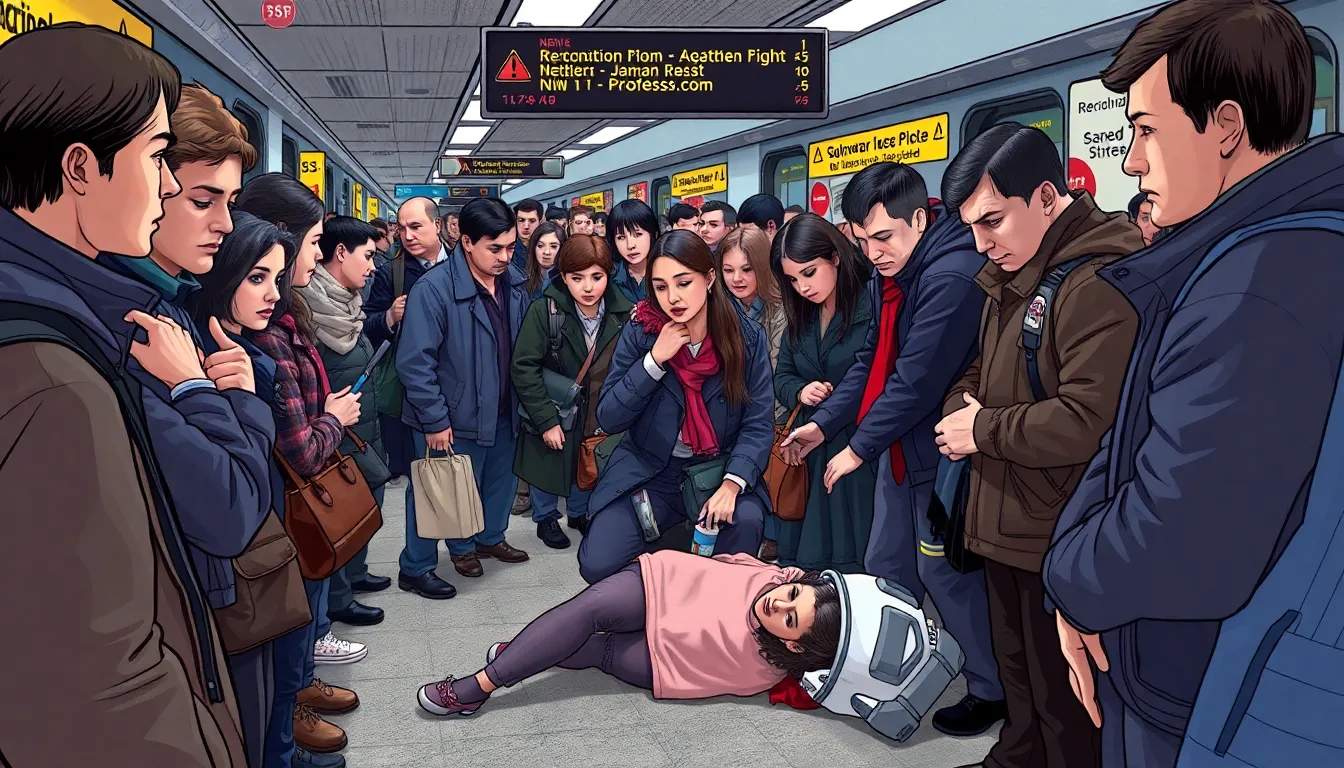In a shocking incident that could only be described as a scene from a twisted movie, a man set a woman on fire in a subway station. This bizarre act of violence has left many scratching their heads, wondering what could possibly drive someone to commit such a horrific crime in broad daylight. It’s not just a headline; it’s a grim reminder of the darker corners of human behavior.
As the investigation unfolds, the public is left grappling with questions about safety in urban spaces and the factors that lead to such extreme actions. This unsettling event has sparked outrage and concern, igniting discussions about mental health, societal pressures, and the need for better support systems. Buckle up as we dive deeper into this chilling story and explore its implications on our daily lives.
Table of Contents
ToggleOverview of the Incident
A man ignited a fire on a woman in a subway station, creating a chaotic scene. Witnesses reported the horrific moment, describing the immediate panic among passengers. The perpetrator used an accelerant, which quickly engulfed the victim in flames. Medical teams arrived promptly, transporting the injured woman to a local hospital for emergency treatment.
Police apprehended the suspect shortly after the attack. Investigators are probing his background, looking for any signs of prior violence or mental health issues. Public safety concerns surged in response to this incident, highlighting the need for better surveillance in subway systems.
Communities expressed outrage over the event, with many calling for heightened security measures. Mental health professionals voiced the importance of understanding potential triggers for such extreme behavior. Officials are reviewing existing support systems, seeking solutions to prevent future occurrences.
This violent act has sparked discussions about societal pressures and the necessity for accessible mental health resources. Leaders at various levels are urging collaboration to address root causes of anger and violence in urban environments. As investigations continue, the focus remains on supporting the victim and ensuring safety for all commuters.
Details of the Attack

The violent subway incident occurred on a typical weekday morning, shocking commuters and drawing immediate attention.
Timeline of Events
Witnesses reported the attack just after 8 AM. The suspect entered the subway station carrying an accelerant. Moments later, he approached the woman and ignited the flames. Panic ensued among bystanders as people rushed to flee the scene. Emergency services arrived quickly, transporting the victim to the hospital within minutes. Law enforcement apprehended the suspect shortly thereafter, initiating an investigation into his actions and motivations. Ongoing interviews with witnesses aim to gather more details about the sequence of events, further informing the emerging narrative surrounding the attack.
Victim’s Condition
Currently, the victim is in critical condition at a local hospital. Medical staff are providing trauma care and monitoring her injuries closely. Severe burns cover significant areas of her body, necessitating specialized treatment. Family members remain at her side, receiving updates from medical professionals. Authorities have not disclosed her identity, respecting her privacy during this distressing time. Community support has poured in, with many expressing hopes for her recovery and safety. The situation reflects broader concerns about violence in public spaces, prompting discussions about comprehensive health and safety measures.
Public Reaction
The horrific subway incident has sparked intense public reactions across the community and beyond. Many individuals express disbelief and outrage, highlighting the urgent need for safety measures in public spaces.
Community Outrage
Outrage within the community remains palpable. Local residents gather at vigils to support the victim, demonstrating solidarity in the face of tragedy. People are demanding accountability and action from authorities to prevent future acts of violence. Numerous social media posts reflect anger, with hashtags calling for justice trending across platforms. Advocacy groups advocate for improved mental health resources, advocating for proactive measures to address underlying issues. Critics emphasize the need for enhanced surveillance and security training for public transport employees to protect vulnerable commuters.
Media Coverage
Media outlets are extensively covering the incident. Major news networks report on the attack, delivering real-time updates about the victim’s condition and the suspect’s apprehension. Investigative articles analyze the psychological and societal factors contributing to such violent behavior. Publications are offering expert opinions on the implications of this event, discussing strategies for improving public safety. Commentary pieces highlight community responses and advocate for systemic changes. Overall, the incident has become a focal point for broader discussions about urban violence and public safety, continuing to dominate headlines.
Legal Consequences
The violent act of setting a woman on fire in a subway station has serious legal ramifications for the perpetrator. Authorities have swiftly moved to address this shocking crime.
Charges Filed
Charges against the suspect include attempted murder and aggravated assault. These legal actions stem from the premeditated nature of the attack, involving an accelerant. Prosecutors also consider additional charges related to the substantial harm inflicted on the victim. Legal experts point to the severity of the crime as justification for a strong prosecutorial stance. Witness testimonies and video evidence from the subway station will play an essential role in building the case against the perpetrator. The court’s proceedings will likely draw significant public interest as updates unfold.
Potential Sentencing
Sentencing for such severe crimes can lead to substantial prison time. Depending on the jurisdiction, convicted individuals could face decades behind bars for attempted murder and related charges. Factors like the victim’s injuries, the use of an accelerant, and any prior criminal history will influence the final sentence. Legal analysts indicate that if the suspect is found guilty, the ramifications could set a precedent for similar future cases. The community’s outrage could pressure authorities to pursue the maximum penalties available under the law. Overall, the potential consequences reflect society’s commitment to addressing violent acts comprehensively.
Prevention Measures
The need for enhanced safety measures in public spaces has become increasingly clear.
Safety Protocol Enhancements
Transit authorities are implementing robust safety protocols. Increase in surveillance systems aims to deter violent acts in subway stations. Additional staff presence during peak hours can provide immediate assistance and intervention. Emergency response training for employees focuses on recognizing and addressing potential threats swiftly. Regular drills help improve preparedness among staff and passengers. Upgrades to lighting and visibility ensure that darker areas receive more attention, minimizing unsafe conditions. Enhanced communication systems enable quicker reporting of emergencies. Passenger education campaigns inform individuals about safety measures and encourage vigilance.
Community Initiatives
Community-driven initiatives play a critical role in preventing violence. Local organizations are mobilizing to establish support networks for victims and their families. Collaborative projects with law enforcement foster increased trust and communication. Neighborhood watch programs encourage residents to take an active role in their surroundings. Mental health workshops equip community members with tools to recognize and respond to signs of distress among peers. Outreach events raise awareness about available resources for those in crisis. Advocacy for more accessible mental health services highlights the urgent need for effective support systems. Together, these initiatives work toward creating safer environments for all.
The subway attack has ignited a critical dialogue about safety and mental health in urban environments. As communities rally for justice and support for the victim, the urgency for systemic change becomes increasingly evident. Enhanced security measures and mental health resources are essential to prevent similar incidents in the future.
Authorities face the challenge of addressing not only the legal ramifications for the perpetrator but also the underlying issues that contribute to such violence. This incident serves as a stark reminder of the need for collaboration among community leaders, law enforcement, and mental health professionals.
By fostering a culture of awareness and support, society can work towards creating safer public spaces and reducing the risk of future tragedies.





